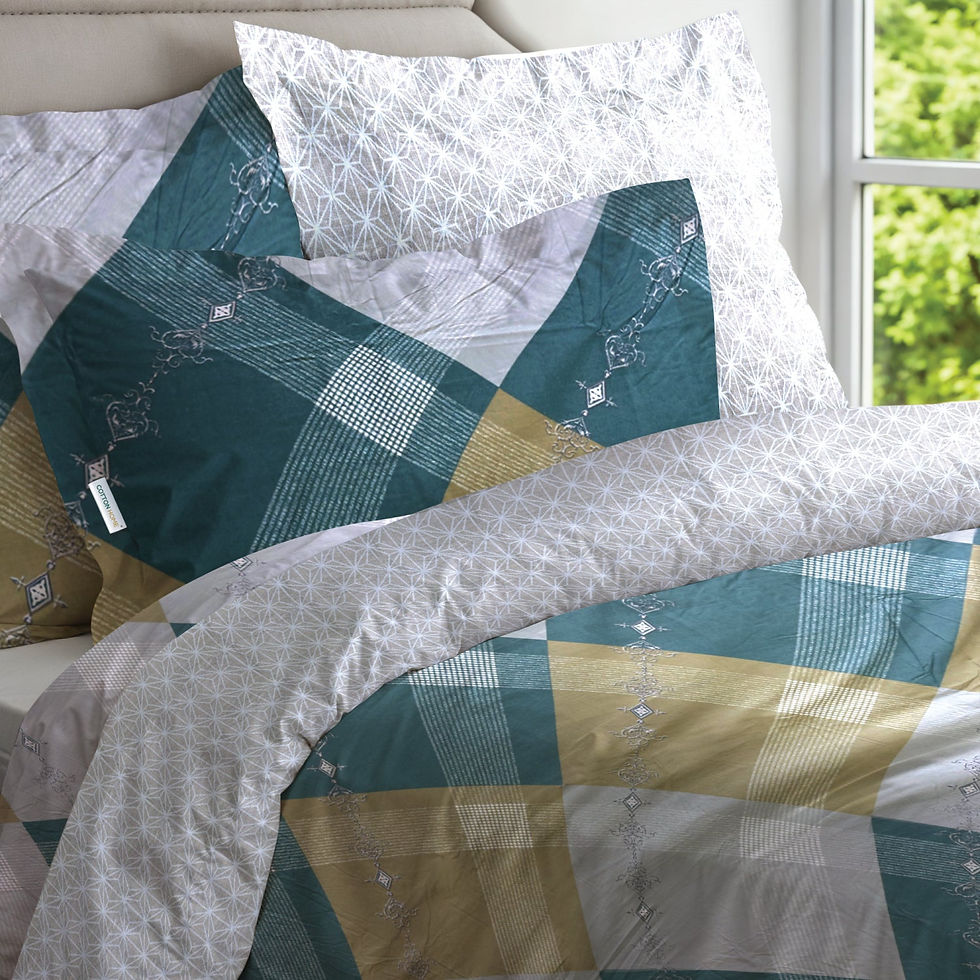How to Choose the Right Size Duvet Cover for Your Bed?
- Cotton Home
- Sep 30
- 4 min read
A good night’s sleep often comes down to the comfort of your bedding, and one essential element that plays a big role is your duvet cover. While choosing the fabric and design is important, picking the right size is equally crucial. An ill-fitting duvet cover can make your bed look untidy, cause the insert to bunch up, or leave you tossing and turning throughout the night. To ensure both comfort and style, let’s dive into how to choose the right size duvet cover for your bed.

Why Does Duvet Cover Size Matter?
Duvet covers aren’t just decorative; they are functional. A properly sized cover ensures that your duvet insert stays evenly distributed and provides consistent warmth. Too small, and you’ll end up with a duvet that doesn’t fully fit inside, causing lumps and discomfort. Too large, and the duvet may slide around, leaving cold spots during the night. Choosing the correct size also enhances the aesthetic appeal of your bed, giving it a clean and well-draped look.
Step 1: Know Your Mattress Size
The first step to finding the right duvet cover is understanding your mattress dimensions. Bed sizes can vary by country, so always double-check the standard measurements in your region. Here are some common mattress sizes and the corresponding duvet cover suggestions:
Single/Twin Bed: Mattress size approx. 90 x 190 cm → Duvet cover size 135 x 200 cm
Double/Full Bed: Mattress size approx. 135 x 190 cm → Duvet cover size 200 x 200 cm
Queen Bed: Mattress size approx. 150 x 200 cm → Duvet cover size 230 x 220 cm
King Bed: Mattress size approx. 180 x 200 cm → Duvet cover size 260 x 220 cm
Super King/California King Bed: Mattress size approx. 200 x 200 cm → Duvet cover size 280 x 240 cm
These are general guidelines, but it’s important to also consider the height (or depth) of your mattress. A thicker mattress or the addition of a mattress topper may require a slightly larger duvet to drape properly.
Step 2: Match Duvet Insert and Cover
Your duvet insert and duvet cover should align closely in size. If the cover is significantly larger, the insert will shift around. If the cover is too small, stuffing the insert inside will be frustrating, and the cover may look overstuffed. Ideally, the duvet cover should either match the insert exactly or be just a couple of centimeters bigger for easy fitting.
Pro Tip: If you prefer a fluffier, lofted look, choose a cover slightly smaller than the duvet insert. This ensures the insert fills the cover completely and eliminates gaps.
Step 3: Consider Overhang and Style Preference
Beyond function, think about how you want your bed to look. Some people prefer the duvet to fall just over the edges of the mattress, while others like a generous overhang for a cozier, hotel-like vibe.
Minimal overhang (insert just covering the mattress): Ideal for modern, minimalist aesthetics.
Generous overhang (insert draping well over the sides): Great for luxurious, layered styling and extra warmth.
For couples, opting for a duvet one size larger than the bed size is often a good idea. For example, using a king duvet on a queen bed ensures both partners have enough coverage.
Step 4: Factor in Regional Variations
Bed and duvet sizes are not universally standardized. A UK king-size duvet, for example, may not match a US king insert. Similarly, European duvet sizes differ slightly from Asian ones. Always check the label and measurements before purchasing, especially if you are buying from international brands or online stores.
Step 5: Practical Tips for Getting It Right
Here are some practical tips to ensure you pick the perfect size:
Measure Twice – Don’t rely only on mattress labels; measure your mattress and duvet insert to be certain.
Check Depth – If your mattress has a topper or pillow-top design, consider upsizing for proper coverage.
Think Ahead – If you’re likely to switch beds or mattresses in the future, a slightly larger duvet cover can give you flexibility.
Layering Considerations – If you use blankets or throws along with a duvet, you may not need a larger cover. However, if the duvet is your primary layer, opt for a generous size.
Look at Washing and Maintenance – Larger covers can be bulky to wash at home. Make sure your washing machine can handle the size before buying oversized covers.
FAQs About Duvet Cover Sizing
Q1: Can I use a queen duvet cover on a double bed?
Yes, but it may look oversized with a lot of overhang. Some people prefer this style for added warmth, but it might not look neat.
Q2: What if my duvet insert and cover sizes don’t match?
If the cover is bigger, use duvet clips or ties to hold the insert in place. If the cover is smaller, it’s better to buy the correct size, as stuffing may damage the cover.
Q3: Should couples go for a larger duvet cover than the bed size?
Absolutely. A larger duvet minimizes “tug-of-war” at night, ensuring both partners stay covered.
Final Thoughts
Choosing the right size duvet cover for your bed is about balancing comfort, style, and practicality. By measuring your mattress, matching your duvet insert, and considering how much overhang you prefer, you can achieve both a cozy night’s sleep and a beautifully styled bed. Remember, the right fit doesn’t just make your bed look better—it also makes it feel better, ensuring restful nights and refreshed mornings.





Comments